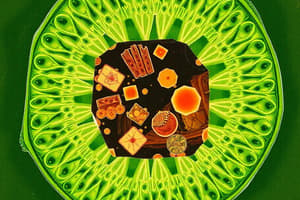Podcast
Questions and Answers
Match the following cell components with their functions:
Match the following cell components with their functions:
Cell wall = Provides support and shape to plant cells Cytoplasm = Contains ground plasm and the cell membrane Cell membrane = Envelops the cell and controls substance passage Chloroplasts = Responsible for photosynthesis
Match the following cell components with their characteristics:
Match the following cell components with their characteristics:
Ground plasm = Liquid contents with dissolved salts and gases Cell membrane = Selectively permeable and controls substance passage Chloroplasts = Contain chlorophyll for trapping radiant energy Cell wall = Formed outside the cell membrane and made of cellulose fibers
Match the following statements with the correct component of a cell:
Match the following statements with the correct component of a cell:
Chemical processes take place in this part of the cell: = Ground plasm Responsible for converting radiant energy to chemical potential energy: = Chloroplasts Only found in plant cells and provides support: = Cell wall Envelops the cell and is selectively permeable: = Cell membrane
Match the following organelles with their functions:
Match the following organelles with their functions:
Match the following terms with their definitions:
Match the following terms with their definitions:
Match the following cell conditions with their descriptions:
Match the following cell conditions with their descriptions:
Flashcards are hidden until you start studying



